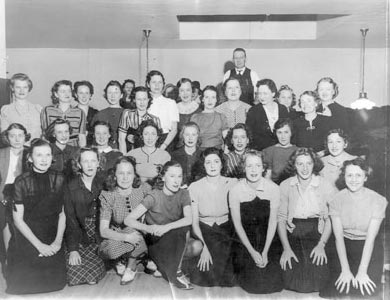


“Margaret Burton was Chester T. Lane’s Administrative Assistant when he was General Counsel, and she ran the DC office with a firm hand.”
- May 15, 1984 Letter to Daniel Goelzer from Homer Kripke on General Counsel’s Office reunion
The New Deal of the administration of President Franklin D. Roosevelt created a wide variety of new government agencies, from the Civilian Conservation Corps to the Works Progress Administration. Each of these agencies needed workers of all kinds, including secretaries, stenographers and telephone operators. The plethora of papers, telephone calls, meetings and reports required persons to type, file, collate, mimeograph and record. These roles were seen primarily as women’s work, and women responded to employment opportunities in these agencies.
The U.S. Securities and Exchange Commission began in 1934 with its headquarters in Washington, and expanded to regional offices around the nation the next year. Its initial Commission and staff list included seven women: three administrative assistants and four secretaries.1 By 1935, about one-third of the SEC staff were women.2 One of them was Martha Stuckel, who worked as secretary to Carl Brown in the Public Utility Division for a Grade Three annual salary of $1,620, more than that of her future husband, who – as a messenger – was classified as Grade Two.3
“Mr. James J. Caffrey, recently appointed Regional Administrator of the New York Office of this Commission, has requested that Mrs. Eleanor J. Townsend be transferred to New York so that she may take up the duties of Administrative Assistant in that office…Mrs. Townsend has a long record of efficient and loyal service. Her unusual administrative abilities makes her invaluable for a permanent place in governmental work.”
- June 7, 1938 Letter to President Franklin Roosevelt from SEC Chairman William O. Douglas
In 1933, Eleanor Townsend was a widow, living in New York, supporting her mother, and desperately seeking employment in the federal government. Townsend had one point in her favor: she knew Marguerite “Missy” LeHand, President Roosevelt’s personal secretary. Through this connection, Townsend secured work with the SEC, serving SEC Chairman Joseph Kennedy as his liaison with the White House. Her value as an administrator was recognized when Townsend requested a transfer to the SEC New York Regional Office. SEC Chairman William Douglas wrote President Roosevelt about the appointment, noting that Townsend had the necessary qualifications to handle all administrative functions. The request culminated in President Roosevelt personally authorizing her transfer to New York by executive order.
“All the stenos down here are on a regular over-time schedule. We had to do that in order to keep up with the [Special Protective Committee] study. Mr. Levy has been cracking his whip steadily, as well as living up to his name of ‘Scribbling Sam.’”
- October 30, 1936 Letter to Professor Abe Fortas from Edith Waters
Women at the SEC began to gain leadership responsibilities. In 1935, Lucile Donovan was Acting Chief of the Library Section and Rosemary Logsdon served as Chief of the Stenographic Section.4 By 1942, Olga Stieg was Assistant Director of the Trading and Exchange Division, where she was involved in matters related to the operations of the National Association of Securities Dealers, Inc.5
The National Association of Securities Dealers, Inc. was established in 1939 to serve as a self-regulatory organization for the investment banking and securities business. Like the SEC, the NASD moved to Philadelphia during World War II “in view of the growing needs of the Government for office space in the Capitol … and in cooperation with the Government’s decentralization program.” 6 By 1944, the NASD national office and district committees combined employed over forty staff, including women stenographers and clerks.7 Martha Norman began work at NASD in 1942 as secretary to the Director of the Investment Companies Department, and retired 25 years later as Assistant Director of the Advertising Department.8
In 1947, the Department of Labor reported that women constituted over 40% of the SEC’s work force, well in excess of the federal agency average of nearly 24%. By the early 1950s, the federal government continued to be the largest single employer of U.S. women, but the occupational fields open to women remained limited. 9
(1) July 1934 SEC Commission and Staff List
(2) July 1935 Telephone Directory, Securities and Exchange Commission
(3) September 16, 2005 Interview with Francis Trainor
(4) July 1935 Telephone Directory, Securities and Exchange Commission
(9) June 30, 1947 Women in the Federal Service, 1923 – 1947; August 31, 1954 Government Careers for Women: A Study of the Salaries and Positions of Women White-Collar Employees in the Federal Service (excerpt)